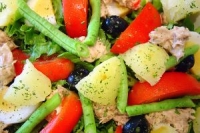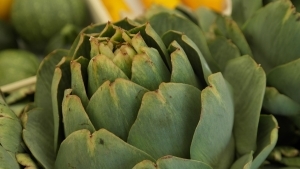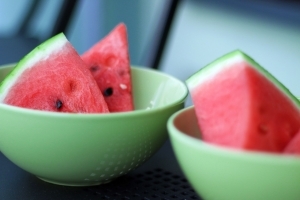Ricotta cheese
Ingredients
-
2 litres | 0.5 gal | 4 pt milk: fresh, whole (3-4%)
-
¼ cup | 2 fl oz white vinegar
-
Bowl of ice
-
Plain salt
-
Method
1. Have your ricotta basket ready (if you have one). If not, prepare a cloth-lined sieve over a bowl, or you can use butter muslin, nylon curtaining or even an open-weave dish cloth so long as they are boiled in water before use to sterilise them.
2. Heat the milk slowly in a bain-marie to 80-90°C (185-195°F) on a medium heat over 10-15 minutes.
3. Add white vinegar, stirring very, very slowly, as slowly as your hand can move. Stop stirring once the curds have formed, about 2 minutes, making sure the temperature stays between 80-90°C(185°-195°F).
4. Gently scoop out the curds with a ladle, place in your lined bowl or basket and cool quickly to get curd set; I place the sieve over a bowl of ice or refrigerate it immediately to get it cold within a couple of minutes. Leave it for one hour, then store in an airtight plastic container in the fridge – you can add salt to taste at this stage or leave it unsalted. Use within 3 days if unsalted, or four days if you do add salt.
Jean’s tips
• You can make ricotta from the whey you have drained off from an earlier-made cheese, so long as you use the whey within 2 hours of removing it from the first cheese. Any longer and the acid levels will rise too much to achieve a separation of curds and whey. Add a cup of whole milk to the whey for a greater yield.
• I don’t salt ricotta until I am ready to use it – depending on the recipe (like cheesecake), I sometimes don’t add salt at all
Ricotta is a ‘now’ cheese, light, milky and ready to be eaten immediately. It’s also a very quick, economical and useful cheese to make that is great in sweet or savoury dishes. It was traditionally made from the whey saved from sheep milk cheeses but this recipe is made with whole milk so you get a much greater yield. The temperature of the milk reaches 85°C (185°F) so you don’t have to pasteurise raw milk beforehand, making it is a safe option for the novice cheesemaker. You can also use any storebought milk that has at least 3% fat – lower than 3% and you won’t make much ricotta.


